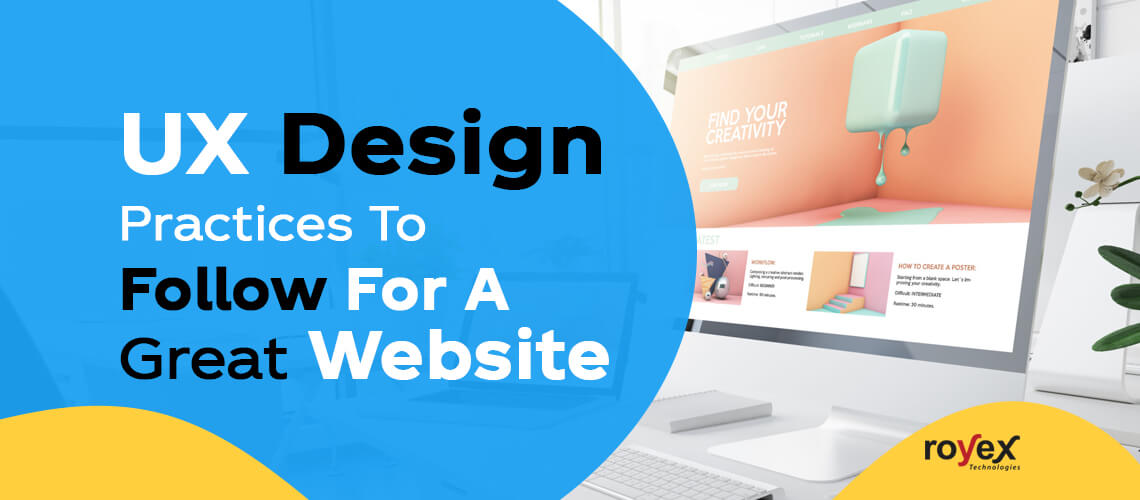
UX Design Practices To Follow For A Great Website
It is not up to you to determine whether or not your company's website is good. You can't make your visitors have a pleasant experience on your website. In the same way that art is subjective, so are websites. Everyone's definition of a great website is going to be a bit different.
The good news is that many website features are universally fantastic, regardless of audience, branding, or style. It's all about the user experience.
First and foremost, you must comprehend what "user experience" means in connection to your company's website, and why it is more important this year than ever before. Then we'll go through the important principles of UX design that will assist you in designing a fantastic website.
Basics of User Experience(UX)

To create an amazing website, you don't need to qualify to be a user experience (UX) designer. However, if you don't grasp the fundamentals of user experience, you won't be able to make the optimal design and content selections for your website. The goal of user experience design, often known as "interaction design," is to create a website that is easy to use.
UX design is like the plan of a home. A blueprint specifies everything from the layout of rooms, window layout, and door opening directions to the positioning of appliances. It ensures that the house is habitable and that there is enough space for all of your belongings.
The same thing is done with UX design, but for your website! All kinds of audiences are considered when targeting a great UX design.
The placement and layout of menus, CTA buttons, highlighted or related content recommendations, and the arrangement of content on a page all contribute to this. The final product is a dynamic prototype of your site, which allows you to evaluate its usability before adding color and content.
A good UX design's main purpose is to give the correct information at the right time, keeping a visitor advancing through the site toward their intended goal.
Importance of UX Design

There are a couple of reasons why UX design is crucial for your website’s performance and the results that you are looking for:
UX facilitates sales funnel movement
There are several methods for someone to find their way to your website. The way a customer discovers you reveals a lot about where they are in the buying process.
All of these possibilities and more are taken into account by UX design, which guarantees that no matter where a user lands, there is a clear message, navigation, and content to guide them to the next step.
This might be from top-of-funnel to middle-of-funnel, such as reading a blog article and then being directed to your case studies. It might also be from the center to the bottom, such as what messaging and functionality aids a user in entering and completing the checkout process.
UX impacts leads and sales
Every company website has a lucrative end objective, whether it's completing a sale or generating a lead. It's natural for a fantastic website to achieve that aim since it provides such a straightforward and pleasurable experience.
The following are UX factors that have a direct influence on leads and sales:
- Size, position, options, and copy for menus
- Context, location, and wording for CTA buttons
- Cart – number of buy stages, copy, and error messages
- Forms - where to put them, how many fields they have, and how to copy it and around them
- Credibility and trustworthiness content – prominence and location
- Location and form issues for gated content
- Data security, communications, and reliability are all apparent characteristics of reliability.
- Mobile-friendliness — doing chores on any device is simple.
A flaw in any of these UX aspects might result in a loss of sales
UX affects SEO rankings
Google is focused on providing great user experiences for its rankings. That is how they have such a large share of the search engine rankings. Google and other search engines work hard to provide useful search results that are ranked using machine learning, artificial intelligence, and NLP.
What exactly is it that Google is looking at? Several of its 200+ ranking components are derived from human contact with your site. Remember that you're aiming for great encounters that search engines will notice.
Even if a page's title and meta description may be what entices a reader to click through from the search results, it's the reader's experience after they arrive that informs Google whether or not you're a decent site that should rank higher for that search query. Some components of a good user experience are managed at the website level, while others are influenced by page design:
- Site loads quickly
- Content that is mobile-friendly and responsive
- The site is safe to use (HTTPS)
- Free of obstructive intrusions that obstruct user flow
- Longer sessions are enticed by the compelling material presentations.
- Low bounce rate
- Designed to be easily accessible
5 UX Design Tips For a Great Website Design

Here are some UX design tips to achieve a great website design:
Make sure there are many paths through your website
Your website isn't a one-way street. There are several approaches for your clients to go from admission to conversion. We also know that B2B audiences need to visit our website numerous times before converting.
A strong user experience design would consider as many different pathways as possible and create a logical information architecture to keep visitors moving toward the ultimate goals.
Menus should be placed in logical locations
You want your website's content discovery to be simple whether you're using a laptop, a tablet, a desktop, or a phone. Menus are expected to be used, and they are expected to be found in 'regular' areas.
Avoid hamburger menus for mobile, and make sure your menus are clearly accessible and clickable. That goes for your main menu and footer menus, as well as any search bars or filtering menus that assist visitors, discover the material they're looking for.
Create a logical user flow
You should pick all options with an emphasis on what will produce a logical user flow, just like you did with menu options. The following are some of the roadblocks that tourists face in attaining their objectives:
- There are much too many various forms of content
- Far too many disruptions (contact boxes, popups. etc)
- There are much too many menu options
Your content will still be easily findable without overpowering the visitor if your website has a solid UX design.
Carefully craft your menu and CTA content
When we encourage a visitor to click on another page, we're essentially asking them to believe us that it'll be worth their time. That's a tall order!
Clear microcopy — the phrases that display on menus and buttons – is the greatest method to keep a customer moving across your website. Despite the fact that these navigational tools usually just include a few words, those words have a significant influence on your conversion rate.
You may use straightforward language like "see all" or "sign up," but don't be afraid to inject some personality if your target group like it. Just make sure what happens when they click is still apparent.
Cater to only one set of the target audience
While most organizations have two or three website audiences, creating content to attract all of them simultaneously is impossible. A good website's content organization, navigation, and messaging are all geared toward assisting a primary audience in achieving its objectives.
This will result in more conversions and better on-page engagement signs (the ones that communicate to search engines).
That isn't to mean you should disregard the opinions of others. Secondary and tertiary audiences can be directed to pages with their own messaging and user flows using navigational tools such as CTAs and menu items.
Do you need any help related to designing websites with minimal cost? Get in touch with us & know more. Royex Technologies is the leading web design company in Dubai providing website development, e-commerce & mobile application development on all scales with quality & flexibility. We have already developed a variety of websites on WordPress, Magento & Umbraco to provide to our clients. Visit our portfolio & connect with us for further details.





